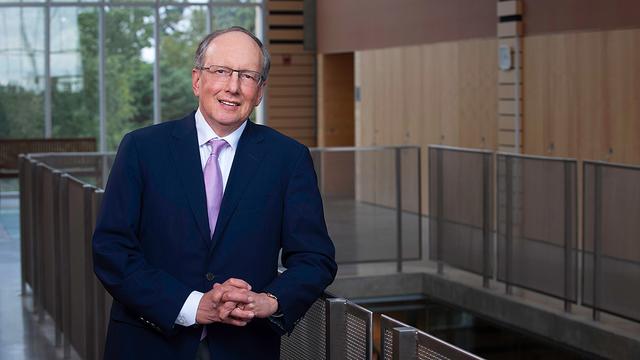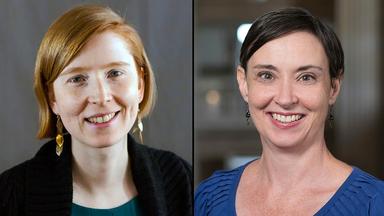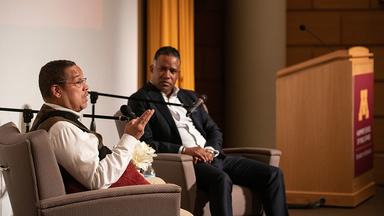on the economy. Photo: Bruce Silcox
The federal government is gaining momentum in addressing concerns about restrictive occupational licensing practices—the rules that require countless professions to license their employees, from doctors and teachers to mechanics, hair braiders and locksmiths.
The Trump administration, Congress, and the Federal Trade Commission (FTC) have all taken steps to look at the practice, and that’s good news according to Humphrey School Professor Morris Kleiner, one of the country’s leading experts on occupational licensing and its influence on the economy.
Kleiner, who has researched the topic for 40 years, has found that the practice of state governments requiring workers to get licenses for a growing number of occupations has significant social costs, with workers not being able to enter or continue in their professions, and consumers paying more for services—as much as 15 percent more when an occupation is licensed.
Kleiner shares his insights into what’s wrong with occupational licensing and how the government can fix it.
What’s happening now at the federal level to address these issues?
The Trump administration has started to look at streamlining some of these licensing regulations. Labor Secretary Alexander Acosta has spoken about the need for reform, and Representative Darrell Issa (R-CA) has introduced a bill in Congress to push for licensing reform on the state level.
It is one of the few areas where there’s bipartisan agreement that something should be done, although for different reasons. Democrats often look at this as an issue of job access for lower-income workers, while Republicans consider it a question of economic liberty in the labor market.
The FTC created its Economic Liberty Task Force to bring more attention to the issue, following a 2015 Supreme Court case it won involving the North Carolina Board of Dentistry. The Board claimed that vendors at shopping malls and spas who were selling teeth whitening kits and showing people how to apply the product were practicing dentistry without a license. The FTC challenged that policy and won, and I think the agency may pursue more of these cases.
We also are starting to see more conversations about occupational licensing in many states, with consumers and legislators asking questions such as whether the barriers are too high, or whether you need licensing at all for many of these occupations when other forms of regulations are available.
You’ve been studying this topic since 1976. What are the most significant developments you’ve noticed during that time?
The biggest difference is the number of occupations that now require a license, which has increased significantly over the years. This trend followed the decline in manufacturing and the expansion of the service sector. In the 1950s, only about 5 percent of the workforce needed to be licensed. Now that’s up to 25 percent of workers who, in essence, need permission from the government in order to work for pay. They can’t do their jobs without that permission. It’s not just doctors, lawyers, and teachers anymore. More than 800 occupations are licensed by at least one state, including personal trainers, hair braiders, interior designers, and even florists in one case.
How are licenses such an important part of the US economic picture?
Because people need to get licenses for so many kinds of jobs, it’s becoming harder for them to break into certain occupations. That’s especially true for low-income workers. For example, if you want to become a cosmetologist, in some states you need to take more than 1,000 hours of training that can cost thousands of dollars. And professional organizations are good at lobbying states to keep those requirements in place and sometimes make them tougher. That way they limit how many people can enter the profession, which lets them charge higher fees and earn higher wages. And licensing generally doesn’t have any large measurable effect on the quality of the service a consumer is receiving.
Why haven’t these rules been addressed until now?
It’s because some powerful interests benefit from the way things are now. The government basically creates a monopoly for these various licensed services. Current members of those occupations have a great deal of self interest in keeping licensing in place, so they can limit the supply of practitioners and charge their customers more. It amounts to only a few dollars in each transaction, so it’s not really worth the effort for consumers to pursue changing the law.
State governments, which do most of the licensing, benefit by collecting licensing fees that are usually greater than the costs of monitoring the regulated occupation. And education institutions benefit by collecting the tuition for the courses that those workers need to take in order to qualify for a license.
Your latest research looks specifically at one of those situations, when licensed workers want to move to a new state.
My colleague at the Humphrey School, Assistant Professor Janna Johnson, worked with me on this research that showed how hard it is for licensed workers to get re-licensure when they move to another state, because the licensing rules are so different in different states. Former first lady Michelle Obama became interested in this issue as it relates to military members who move frequently from state to state. Their “trailing spouses” often have to pay for more training and take additional exams to get a license to work in their profession in the new state. And then they move again in a year or two and have to do it all over again.
Teachers probably have among the hardest times with this because each state’s licensing requirements are quite different from each other. It can take a fairly long time and cost quite a lot of money to fulfill those requirements, so that makes it much tougher for teachers to get re-licensed in a new state.
The overall interstate migration rate is about half what it was in 1980, and it can reduce the efficiency of the labor market in the economy. When people can move to a place where their services are most in demand, economists call that “labor market churning.” The different licensing rules in each state are limiting that churn by making it harder for workers to move where they want to go.
Popular ride-sharing services like Uber and Lyft are in the middle of this debate now, too.
And once again we have a patchwork of regulations on these services, mostly at the city level. For example, in New York City, if you want to be a licensed Uber driver, you have to meet the same requirements as a taxi driver. That means taking classes for up to several months, passing a variety of exams, and spending several thousand dollars. Only licensed drivers can pick up someone in New York City. There are fewer ride-sharing drivers per capita relative to other cities where regulations are dramatically less. And fares for Uber in NYC are about the same as cab fare.
Compare that to New Jersey, right across the river, where there aren’t many regulations. We haven’t found there’s much difference in the quality of the rides as measured by abrupt braking and accelerations, and by the ratings Uber collects on drivers by surveying customers. So licensing leads to fewer Uber drivers, higher prices, and not much difference in consumer quality.
What do you recommend to improve current licensing practices?
First of all, we have to recognize that occupational licensing is not going away anytime soon, and it will probably continue to expand as new types of services are created in our economy. But we need to make changes to allow more people access to these jobs, and to give them more flexibility to move to where they want to live without dropping out of their occupation. Here are my recommendations.
- State agencies should perform a cost-benefit analysis on every request for new occupational licensing requirements, to determine whether they’re warranted.
- States should revise their licensing standards to allow workers to move across state lines with a minimal cost for retraining or residency requirements.
- The federal government should promote best-practice models for licensing through financial incentives and better information.
- Where politically feasible, certain occupations that are licensed should be reclassified to a system of certification or no regulation.
If federal, state, and local governments were to take on these proposals, we would likely see more employment in these regulated occupations and consumers would have greater access to these services at lower prices.


